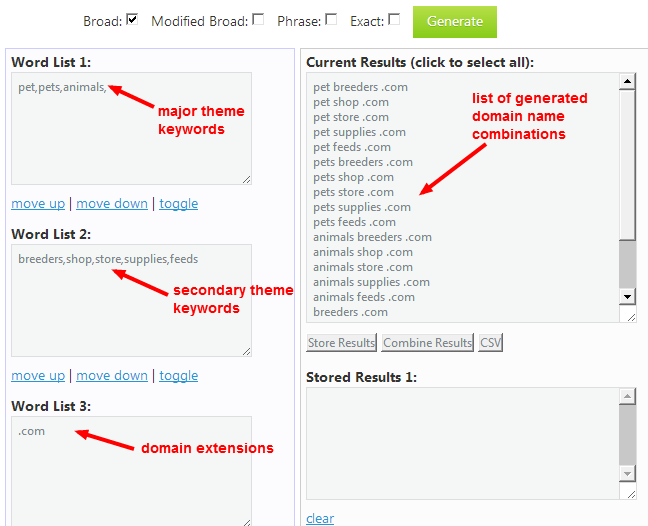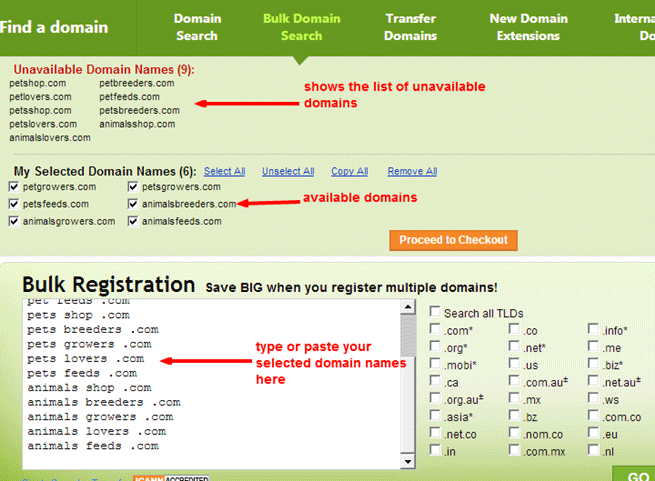The aim of this guide is to help the store owner create a list of rich keywords that describes the store through a step-by-step instruction so to create a very good name appropriate for the store.
Choosing the name of the store is an important opportunity for your business.
A good store name will be easy to remember and easy to pronounce. This process will help you to find a list of potential store names that can be converted into a domain name.
A good domain name will:
- describe your store
- be short and sweet
- use words that will give people an instant perception of what you are offering
- be unique and not used by other popular sites to avoid confusion and possible copyright infringement
- avoid using hyphens and numbers like these are hard to remember
- be easy to type and memorize so that customers can easily remember it whenever they want to go back or share this to others
- remind customers of the products you are selling
- use a .com or be appropriate to where they live (i.e: .com.au for Australia, .co.uk for the United Kingdom)
- be available as usernames on the most popular social channels (i.e: Twitter, Google+, Facebook)
This task will usually take around 2 to 4 hours of concentrated effort. It is a combination of common sense, inspiration and research.
Our aim is to create many choices and then cull that list down to just a few good ideas.
Step 1: Create A List Of Major Theme Keywords

- Start by writing a list of the major theme keywords. Just write down all the words that pop into your mind. For example, the major theme keywords for a store that sells pet supplies would be “pet”, “pets” and “animals”.
- You can also use a Thesaurus tool. This will give you suggestions for synonyms. Type your major theme keywords, one at a time, into the Thesaurus. Look through the results and decide which new synonyms you will add to your list.
- Advanced practitioners can also use Google’s Keyword Research Tool. It is located in Google Adwords.
Step 2: Create A List of Secondary Theme Keywords
It is unlikely that you will be able to register a store name using just the theme words. You are more likely to find an available name if you combine a major theme keyword with a secondary theme keyword.
- Next, write a list of all the secondary theme keywords you can think of. For example, if we have a store that sells pet supplies it might “accessories”, “supplies”, “equipment” etc. Use the Thesaurus to add more ideas to your list.
- You can also use a generic list of keywords that describe an eCommerce business. Although these keywords lack imagination they can be a useful starting point. i.e: Store, Shop, Hub, Stock, Supply, Suppliers, Dept
- If location is important to your customers then you can also use geographical references. i.e: Oz is slang for Australia. The USA is the shortened version of the United States of America
- Alliteration can also provide you with a useful list of words. Go through the Dictionary (i.e: http://dictionary.reference.com/list/c) and find words that start with the same letter as your theme word. Eg: Camping+Cove
- Use Google’s Keyword Tool to give preference to keywords that are are more popular with customers. i.e: bigtents.com or familytents.com. Does the phrase “big tents” or “family tents” get more keyword searches each month?
Sample List Of Business Secondary Words
direct, pro, point, hub, stock, supply, suppliers, wholesale, factory, stuff, gear, provisions, materials, stockpile, collection, pantry, dept, city, club, heart, town, station, hall, dock, terminal, place, metropolis, hq, headquarters, mall, shopping center, market, marketplace, mart, plaza, superstore, megastore, store, storehouse, shop, provender, accessories, supplies, equipment.
Step 3: Automatically Create Domain Name Combinations

You should now have 3 or 4 separate lists of keywords. It is important that they are separate lists of words. Each word should be separated by a comma. Eg: word, word, word, word, word, word
SEOBook’s tool will combine your lists into many, many variations of domain names.
This tool will automatically combine all the words you have suggested.
- Next, you need to create a very short list of domain endings. If your store is located in the USA you might only want .com. If you are located in Australia, you might want .com.au. Perhaps you are planning an expansion into .co.uk as well? Write the list like this — > .com, .com.au, .co.uk
- Now, use http://tools.seobook.com/keyword-list/generator.php to quickly combine the keywords into many different combinations. The full instructions are here.
- Add your major theme keywords to Word List 1
- Add your secondary theme keywords to Word List 2
- Add your domain extensions to Word List 3
- You will now have a very long list of domain names. Discard any domains that are completely unappealing. Save the list.

Step 4: Check Domain Name Availability
Now we will check whether the domain names are available for registration.
- Go to GoDaddy’s Bulk Registration tool. GoDaddy offers a wide selection.
- You can also search Google for “bulk domain name registration” to find other examples.

Step 5: Check Availability In Social Networks
If you have found a name that you think will be suitable, you will still need to check that it is generally available in social media accounts.
- Use Knowem.com tool to quickly check availability in multiple networks.
- If the name is not available, try adding com or store or web or hub to the end of the name. Eg: Use pinterest.com/paperistascom instead of pinterest.com/paperistas. Sometimes this minor variation will be available instead. Our main interest is whether a suitable username is available for Facebook Page, Pinterest, YouTube, Twitter, Tumblr and Wanelo.
- Add the availability and potential username into the list of contenders.

You will now have a useful list of domains names that are both available in the common domain (i.e: available for registration) and also available in social media.
Final Checklist
Creating an effective name for your store may require more time than you think. Here’s a summary of the above steps to keep them in your mind:
- Create a list of major theme keywords that pops out of your head.
- Then create a list of secondary theme keywords that you can combine with your major theme keyword.
- Create domain name combinations.
- When you have the list, check this domain availability through domain registrars.
- As well as check their availability in social networks.

